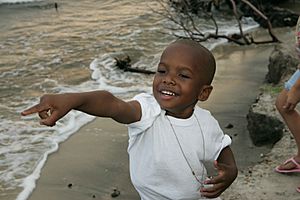Direction facts for kids
Direction is how we describe where something is going or where it's located compared to something else. Imagine an invisible line connecting two points; if something moves along that line, it's following a specific direction. People often show direction by pointing with their hands or bodies. The word "direction" comes from "direct," which means to guide or show the way.
Contents
What is Direction?
Direction helps us understand movement and position. It tells us which way to go or where something is in space. Think about playing a game; you might be told to run forward or turn left. These are all ways we use direction every day.
Everyday Directions
We use many words to talk about direction in our daily lives. Some common ones describe movement relative to ourselves or another object:
- Up: Moving towards the sky or a higher place.
- Down: Moving towards the ground or a lower place.
- Left: Moving towards the left side.
- Right: Moving towards the right side.
- Forward: Moving ahead or in front.
- Backward: Moving behind or to the rear.
For larger areas or when using maps, we often use special directions called cardinal directions. These are based on the Earth's poles and the sun's path:
- North: Towards the North Pole.
- South: Towards the South Pole.
- East: The direction where the sun rises.
- West: The direction where the sun sets.
There are also in-between directions like Northeast, Southeast, Southwest, and Northwest. These directions are very important for navigating with a compass or reading maps, helping people find their way across land, sea, or air.
Why is Direction Important?
Understanding direction is super important for many reasons. It helps us:
- Find our way: Whether you're walking to a friend's house or exploring a new city, knowing directions helps you get there.
- Give instructions: Imagine telling someone how to find a hidden treasure; you'd need to give clear directions!
- Play sports: Athletes need to know which direction to run, kick, or throw the ball.
- Understand maps: Maps use directions to show where places are located relative to each other.
- In science: Scientists use directions to describe the movement of planets, the flow of rivers, or the path of light.
Direction is a basic concept that helps us make sense of the world around us and move through it effectively.
Related Pages
See also
 In Spanish: Dirección para niños
In Spanish: Dirección para niños


